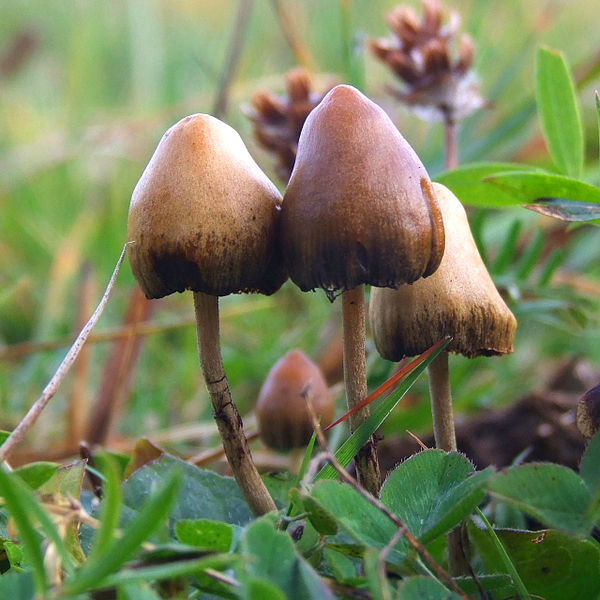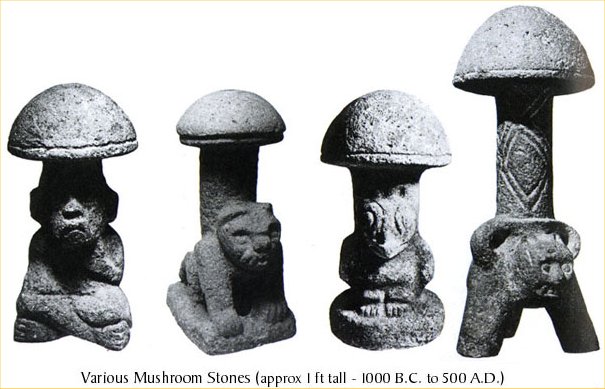The story begins on the morning of October 3rd 1799. A poor man can be seen in the gloomy dawn light gathering field mushrooms in London's Green Park. When he gets home, the mushrooms are cooked with flour, water and salt to provide a morning broth for him, his wife and their four children.
morning broth for him, his wife and their four children.
A few hours later Everard Brande, a doctor, is summoned to the household where the family are experiencing strange symptoms. The father has developed vertigo and disturbed vision; the rest of the family complain of poisoning and stomach cramps with their extremities becoming cold. Their pulses and breathing oscillate between frightening highs and lows. The family are overwhelmed with the fear of dying - all, that is, except eight year old Edward, who is "attacked with fits of immoderate laughter".
Nowadays we can be fairly certain that the strange symptoms experienced by the family 200 years ago were the result of accidental consumption of Liberty Cap mushrooms. Or, to give them the name by which they are better know, "magic mushrooms" or "shrooms".
These grow widely in the UK and continental Europe in the autumn. They carry the name "Liberty Cap" because of their resemblance to the Phrygian Cap, commonly seen as a symbol of liberty.
Magic mushrooms
Liberty Cap mushrooms (Psilocybe semilanceata) are part of the large family of up to 200 species of Basidiomycota mushroom that contain the psychedelic drug psilocybin. These mushrooms are found in many parts of the world, with the Psilocybe genus being the major type. Psilocybe have long been associated with ritual because of their ability to change human perception - the "psychedelic" effect. Evidence has been found in Algeria, Mexico and Spain for their use in religious ceremonies. The Aztecs called them teonanacatl (divine mushroom) and the mushrooms were reportedly served at the coronation of Moctezuma II in 1502. Use of Psilocybe by the Aztecs was suppressed following the Spanish conquest, but they continued to be used covertly by native Indians in this part of America.
Little was known about these ceremonies in the US and Europe until husband and wife team Gordon and Valentina Wasson travelled to  Mexico in the 1950s. Their aim was to understand the culture associated with the "divine mushroom" and they made several visits to Mexico at that time. In 1955, Gordon Wasson was one of the first westerners to participate in an indigenous mushroom ceremony. Wasson wrote an article for the popular magazine "Life" in 1957, describing the mushroom ceremony and the sensations he experienced. The French mycologist, Roger Heim, accompanied the Wassons on one visit and Heim identified the mushrooms as Psilocybe mexicana.
Mexico in the 1950s. Their aim was to understand the culture associated with the "divine mushroom" and they made several visits to Mexico at that time. In 1955, Gordon Wasson was one of the first westerners to participate in an indigenous mushroom ceremony. Wasson wrote an article for the popular magazine "Life" in 1957, describing the mushroom ceremony and the sensations he experienced. The French mycologist, Roger Heim, accompanied the Wassons on one visit and Heim identified the mushrooms as Psilocybe mexicana.
The next step was to identify the active chemical in the mushrooms, so samples were given to Albert Hofmann at Sandoz in Basel. Hofmann was already well known as the chemist who had first synthesised the related psychedelic drug LSD in 1938, and who later inadvertently experienced the effects of the drug himself. Hofmann made extracts of the Psilocybe and analysed the constituents for their psychological effects, often testing the extracts on himself. He showed that there were two principal active compounds in the mushrooms, psilocybin and psilocin; once ingested, psilocybin is rapidly converted to psilocin.
The effects of psilocybin and LSD
So what are the effects of psilocybin and psilocin on humans? Psilocybin has effects rather similar to the two other principal psychedelic drugs, mescaline and LSD, although there are differences in detail and in potency. Sol Snyder, in his book Drugs and the Brain, describes how he took LSD to document and understand its effects. This is an excellent description from a respected scientist; he reports changes in sensory perception, especially visual effects. Objects may seem distorted, change colour or even move. Confusion between sensory modalities (synaesthesia) may also occur. Sense of time and space are altered but it is the effect on the sense of self that is particularly striking. "Boundaries between self and non-self evaporate, giving rise to a serene sense of being at one with the universe." He goes on to speculate: "The almost predictable transcendence of ego boundaries brought on by these drugs has caused scientists to consider that there might be a neural basis for the ego." Others report heightened awareness, super-reality and mystical experiences after taking the drug. Many people have enjoyed the effects produced by these drugs, which sometimes offer insights not available in normal life. For others it is an unpleasant experience and a minority have injured or killed themselves as a result of disorientation caused by changed perception or loss of self. The experience may depend on the state of the individual and their environment when they take the drug ("set and setting"). More recently a five-component scale has been devised to provide a semi-quantitative measure of the effects of these drugs.
Mechanisms of action of psilocybin and LSD
So, how are these curious effects on human consciousness achieved by these drugs? In the case of psilocybin and LSD, it is thought that the drugs hijack some of the normal processes in the brain. Brain function depends on the release of chemicals termed neurotransmitters. These are detected by their binding to specialised proteins called receptors. One neurotransmitter that is important for regulating a host of functions in the brain and elsewhere is serotonin. This neurotransmitter regulates behaviour, mood, sleep, appetite and blood flow. Psilocybin and LSD both bind to and activate receptors for serotonin that are present throughout the nervous system, so it is not surprising that they have such broad impacts on beaviour and function.
To probe these effects more deeply, scientists have begun brain scanning individuals using the agent, but so far the results are unclear. One study found brain activation  when psilocybin was administered to human volunteers, whereas another study reported reduced activity, so further work is required.
when psilocybin was administered to human volunteers, whereas another study reported reduced activity, so further work is required.
Therapeutic use of psilocybin
In the 1950s it was felt that drugs such as LSD and psilocybin held promise as therapeutic agents and they were used during psychotherapy to lower psychological defences and to facilitate emotional insight. In the 1960s the effects of psilocybin were studied by the Harvard Professor Timothy Leary, who became notorious for his work on psychedelics. Leary's eventual dismissal from Harvard fuelled the growing view at the time that use of these drugs was a form of cultural rebellion. The drugs were increasingly discussed by the media in terms of their potential for abuse and there were moves by the authorities to ban the drugs. Now, LSD, psilocybin and mescaline are controlled drugs in most countries. Somewhat anomalously, the Psilocybe mushrooms were not initially controlled and even in the early years of the 21st century there were shops freely selling "shrooms" in London. In 2005 the law in the UK was changed and the mushrooms were included in the ban, but as with other controlled drugs nowadays, it is still possible to buy the mushrooms via internet suppliers.
When the drugs became illegal this inhibited research on their therapeutic uses almost completely. Recently there has been a resurgence of interest and several careful studies have been performed on the effects of psilocybin on humans.
Franz Vollenweider and colleagues in Zurich have carefully examined the effects of psilocybin on humans, cataloguing the psychological effects using standard rating scales. Based on their observations, they concluded that, although there is a small risk of a bad reaction to psilocybin, which could include dysphoria, anxiety or panic, the administration of moderate doses of the drug to healthy, high-functioning and well-prepared subjects is associated with acceptable levels of risk providing it is done in a carefully monitored research environment. They did state, however, that this did not apply to recreational or less-controlled studies.
Roland Griffiths and colleagues at Johns Hopkins in the US have also examined the effects of psilocybin with a focus on spirituality. They administered psilocybin under controlled conditions to a group of human volunteers who regularly participated in religious or spiritual ceremonies. The acute perceptual and subjective effects of the drug included a complete mystical experience for 61% of those tested and/or extreme fear and anxiety in 39% of those tested. One month after testing, about two thirds of the participants rated the experience as having substantial personal and spiritual significance leading to positive change in attitude, mood and behaviour. 14 months later, these feelings were undiminished. These are fascinating observations, suggesting that psilocybin has considerable potential for changing human behaviour.
Psilocybin has also been reported to have useful effects in treating obsessive-compulsive disorder, cluster headache and anxiety associated with terminal cancer.
The future for research on psychedelics?
After a hiatus of 40 years, research on psychedelics has begun again, albeit slowly. Drugs such as psilocybin hold great promise as therapeutic agents and as tools for understanding human consciousness, providing they are used under controlled conditions. It is difficult to avoid the conclusion that by banning psilocybin we may have missed out on many useful effects of this drug.










Comments
Add a comment